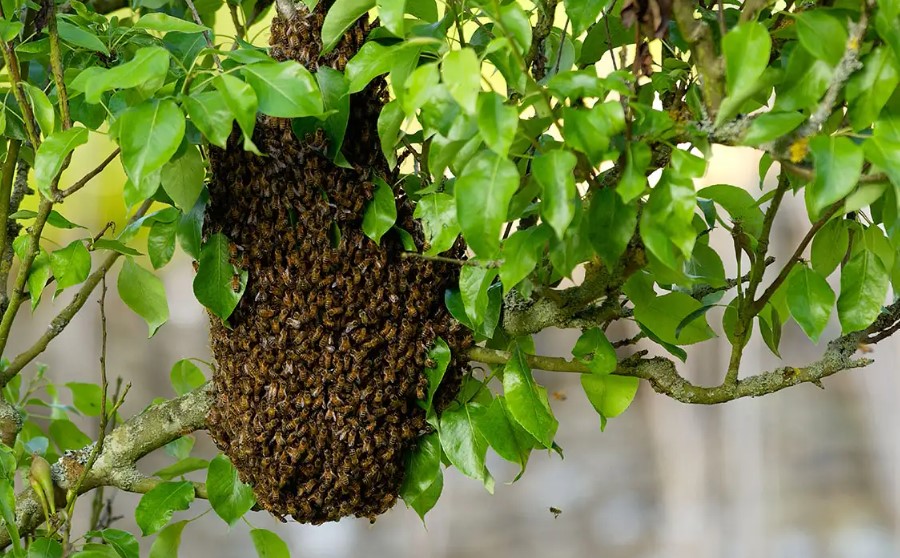

Honey bee swarms are a great opportunity for beekeepers to expand their colonies without spending money on new bees. If you set up the right trap in the right location, you can attract a swarm and give them a new home. In this guide, we will discuss everything you need to know about attracting a honey bee swarm to your trap, from choosing the best location to using the right bait.
Understanding Why Honey Bees Swarm
Honey bees swarm as a natural way of reproducing and expanding their colonies. When a hive becomes too crowded, the queen and a large group of worker bees leave to find a new home. This is when beekeepers have a chance to capture a swarm by providing an attractive location for them to settle. A successful swarm trap mimics the natural places where bees prefer to build their new home, such as hollow trees or abandoned structures.
Choosing the Best Location for Your Bee Swarm Trap
The location of your swarm trap is one of the most important factors in attracting honey bees. Bees look for safe, sheltered areas that protect them from harsh weather and predators. Here are some tips for choosing the best location:
- Height Matters – Place your trap at least 10 to 15 feet above the ground to mimic the natural preference of honey bees.
- Away from Disturbances – Avoid placing the trap near human activity, loud noises, or strong smells that could scare bees away.
- Near Existing Colonies – If you know of wild bee colonies or other beekeepers nearby, setting up a trap in that area increases your chances of attracting a swarm.
- Good Sunlight Exposure – shipping honey bees prefer locations with some morning sunlight to help keep their new home warm.
Selecting the Right Swarm Trap
Swarm traps come in different shapes and sizes, but certain features make them more attractive to honey bee swarms. Here’s what you should consider when choosing or building a trap:
- Size and Volume – The ideal trap size should be between 30 and 40 liters, which is similar to the space bees naturally seek.
- Material – Wooden boxes or old beehive equipment work best because they provide natural insulation and smell familiar to bees.
- Entrance Size – A small entrance (around 1 to 2 inches) is ideal because it gives bees easy access while keeping predators out.
- Ventilation – Small ventilation holes help prevent moisture buildup inside the trap.
Using the Right Lure to Attract a Swarm
To make your swarm trap more attractive, you need to use the right bait or lure. Honey bees look for specific smells that remind them of a safe home. The best lures include:
- Lemongrass Oil – This mimics the natural pheromones of queen bees and can be applied to the inside of the trap.
- Beeswax – Rubbing the inside of the trap with melted beeswax makes it smell like a previous beehive, which attracts swarms.
- Old Hive Frames – If you have old frames with drawn comb, placing them inside the trap will make it more appealing to bees.
Checking and Maintaining Your Swarm Trap
Once your trap is set up, regular monitoring is necessary to ensure it remains attractive and in good condition. Follow these maintenance tips:
- Inspect Weekly – Check your trap every few days to see if a swarm has moved in.
- Keep It Clean – Remove debris, dead insects, or any other obstructions that might deter bees.
- Reapply Lures – Refresh lemongrass oil and beeswax every few weeks to keep the scent strong.
What to Do After Catching a Swarm
If your trap successfully attracts a swarm, it’s time to move them to a permanent hive. Here’s how to do it safely:
- Move at the Right Time – The best time to relocate the swarm is in the evening when most of the bees are inside the trap.
- Prepare a Hive – Have a hive ready with frames and food to make the transition smooth.
- Transfer the Bees Carefully – Gently shake or brush the bees into the new hive, making sure the queen is inside.
- Monitor the New Colony – Keep an eye on the bees for the next few weeks to ensure they are settling in well.
Common Mistakes to Avoid
Many beekeepers make mistakes when setting up swarm traps, reducing their chances of success. Here are some common errors to avoid:
- Using a Trap That’s Too Small – Bees need enough space to start their new colony.
- Placing the Trap in a Bad Location – If the trap is too low or exposed, bees may not find it attractive.
- Neglecting Maintenance – A dirty or abandoned trap will not attract bees.
- Forgetting to Check for Pests – Ants, wasps, or other insects can take over an unmaintained trap.
Attracting a honey bee swarm to your trap requires the right strategy, patience, and attention to detail. By choosing a good location, using the best materials, and applying effective lures, you can successfully capture a healthy swarm and grow your bee colonies. Swarm trapping is a cost-effective and natural way to become a beekeeper, and with proper care, you can enjoy the benefits of fresh honey and pollination support for years to come.
